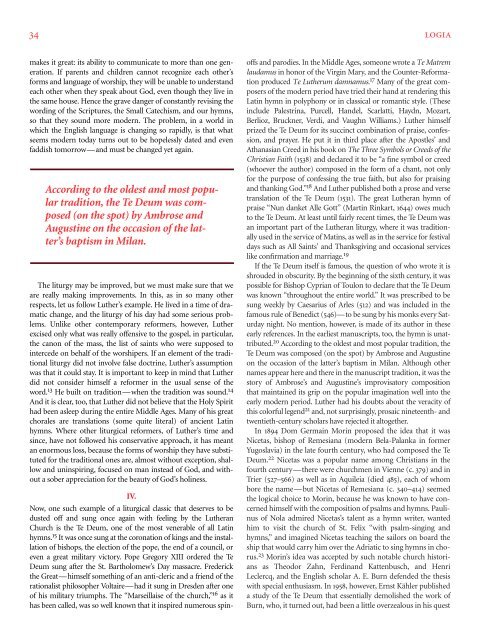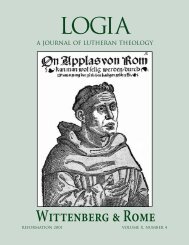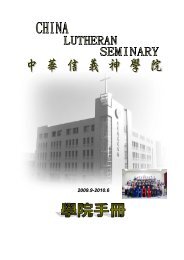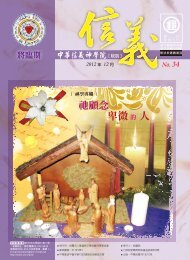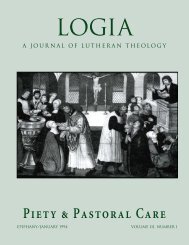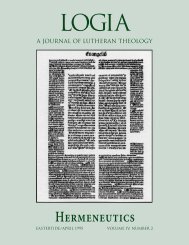05-4 Theology of the..
05-4 Theology of the..
05-4 Theology of the..
Create successful ePaper yourself
Turn your PDF publications into a flip-book with our unique Google optimized e-Paper software.
34 LOGIA<br />
makes it great: its ability to communicate to more than one generation.<br />
If parents and children cannot recognize each o<strong>the</strong>r’s<br />
forms and language <strong>of</strong> worship, <strong>the</strong>y will be unable to understand<br />
each o<strong>the</strong>r when <strong>the</strong>y speak about God, even though <strong>the</strong>y live in<br />
<strong>the</strong> same house. Hence <strong>the</strong> grave danger <strong>of</strong> constantly revising <strong>the</strong><br />
wording <strong>of</strong> <strong>the</strong> Scriptures, <strong>the</strong> Small Catechism, and our hymns,<br />
so that <strong>the</strong>y sound more modern. The problem, in a world in<br />
which <strong>the</strong> English language is changing so rapidly, is that what<br />
seems modern today turns out to be hopelessly dated and even<br />
faddish tomorrow—and must be changed yet again.<br />
According to <strong>the</strong> oldest and most popular<br />
tradition, <strong>the</strong> Te Deum was composed<br />
(on <strong>the</strong> spot) by Ambrose and<br />
Augustine on <strong>the</strong> occasion <strong>of</strong> <strong>the</strong> latter’s<br />
baptism in Milan.<br />
nb<br />
The liturgy may be improved, but we must make sure that we<br />
are really making improvements. In this, as in so many o<strong>the</strong>r<br />
respects, let us follow Lu<strong>the</strong>r’s example. He lived in a time <strong>of</strong> dramatic<br />
change, and <strong>the</strong> liturgy <strong>of</strong> his day had some serious problems.<br />
Unlike o<strong>the</strong>r contemporary reformers, however, Lu<strong>the</strong>r<br />
excised only what was really <strong>of</strong>fensive to <strong>the</strong> gospel, in particular,<br />
<strong>the</strong> canon <strong>of</strong> <strong>the</strong> mass, <strong>the</strong> list <strong>of</strong> saints who were supposed to<br />
intercede on behalf <strong>of</strong> <strong>the</strong> worshipers. If an element <strong>of</strong> <strong>the</strong> traditional<br />
liturgy did not involve false doctrine, Lu<strong>the</strong>r’s assumption<br />
was that it could stay. It is important to keep in mind that Lu<strong>the</strong>r<br />
did not consider himself a reformer in <strong>the</strong> usual sense <strong>of</strong> <strong>the</strong><br />
word. 13 He built on tradition—when <strong>the</strong> tradition was sound. 14<br />
And it is clear, too, that Lu<strong>the</strong>r did not believe that <strong>the</strong> Holy Spirit<br />
had been asleep during <strong>the</strong> entire Middle Ages. Many <strong>of</strong> his great<br />
chorales are translations (some quite literal) <strong>of</strong> ancient Latin<br />
hymns. Where o<strong>the</strong>r liturgical reformers, <strong>of</strong> Lu<strong>the</strong>r’s time and<br />
since, have not followed his conservative approach, it has meant<br />
an enormous loss, because <strong>the</strong> forms <strong>of</strong> worship <strong>the</strong>y have substituted<br />
for <strong>the</strong> traditional ones are, almost without exception, shallow<br />
and uninspiring, focused on man instead <strong>of</strong> God, and without<br />
a sober appreciation for <strong>the</strong> beauty <strong>of</strong> God’s holiness.<br />
IV.<br />
Now, one such example <strong>of</strong> a liturgical classic that deserves to be<br />
dusted <strong>of</strong>f and sung once again with feeling by <strong>the</strong> Lu<strong>the</strong>ran<br />
Church is <strong>the</strong> Te Deum, one <strong>of</strong> <strong>the</strong> most venerable <strong>of</strong> all Latin<br />
hymns. 15 It was once sung at <strong>the</strong> coronation <strong>of</strong> kings and <strong>the</strong> installation<br />
<strong>of</strong> bishops, <strong>the</strong> election <strong>of</strong> <strong>the</strong> pope, <strong>the</strong> end <strong>of</strong> a council, or<br />
even a great military victory. Pope Gregory XIII ordered <strong>the</strong> Te<br />
Deum sung after <strong>the</strong> St. Bartholomew’s Day massacre. Frederick<br />
<strong>the</strong> Great—himself something <strong>of</strong> an anti-cleric and a friend <strong>of</strong> <strong>the</strong><br />
rationalist philosopher Voltaire—had it sung in Dresden after one<br />
<strong>of</strong> his military triumphs. The “Marseillaise <strong>of</strong> <strong>the</strong> church,” 16 as it<br />
has been called, was so well known that it inspired numerous spin-<br />
<strong>of</strong>fs and parodies. In <strong>the</strong> Middle Ages, someone wrote a Te Matrem<br />
laudamus in honor <strong>of</strong> <strong>the</strong> Virgin Mary, and <strong>the</strong> Counter-Reformation<br />
produced Te Lu<strong>the</strong>rum damnamus. 17 Many <strong>of</strong> <strong>the</strong> great composers<br />
<strong>of</strong> <strong>the</strong> modern period have tried <strong>the</strong>ir hand at rendering this<br />
Latin hymn in polyphony or in classical or romantic style. (These<br />
include Palestrina, Purcell, Handel, Scarlatti, Haydn, Mozart,<br />
Berlioz, Bruckner, Verdi, and Vaughn Williams.) Lu<strong>the</strong>r himself<br />
prized <strong>the</strong> Te Deum for its succinct combination <strong>of</strong> praise, confession,<br />
and prayer. He put it in third place after <strong>the</strong> Apostles’ and<br />
Athanasian Creed in his book on The Three Symbols or Creeds <strong>of</strong> <strong>the</strong><br />
Christian Faith (1538) and declared it to be “a fine symbol or creed<br />
(whoever <strong>the</strong> author) composed in <strong>the</strong> form <strong>of</strong> a chant, not only<br />
for <strong>the</strong> purpose <strong>of</strong> confessing <strong>the</strong> true faith, but also for praising<br />
and thanking God.” 18 And Lu<strong>the</strong>r published both a prose and verse<br />
translation <strong>of</strong> <strong>the</strong> Te Deum (1531). The great Lu<strong>the</strong>ran hymn <strong>of</strong><br />
praise “Nun danket Alle Gott” (Martin Rinkart, 1644) owes much<br />
to <strong>the</strong> Te Deum. At least until fairly recent times, <strong>the</strong> Te Deum was<br />
an important part <strong>of</strong> <strong>the</strong> Lu<strong>the</strong>ran liturgy, where it was traditionally<br />
used in <strong>the</strong> service <strong>of</strong> Matins, as well as in <strong>the</strong> service for festival<br />
days such as All Saints’ and Thanksgiving and occasional services<br />
like confirmation and marriage. 19<br />
If <strong>the</strong> Te Deum itself is famous, <strong>the</strong> question <strong>of</strong> who wrote it is<br />
shrouded in obscurity. By <strong>the</strong> beginning <strong>of</strong> <strong>the</strong> sixth century, it was<br />
possible for Bishop Cyprian <strong>of</strong> Toulon to declare that <strong>the</strong> Te Deum<br />
was known “throughout <strong>the</strong> entire world.” It was prescribed to be<br />
sung weekly by Caesarius <strong>of</strong> Arles (512) and was included in <strong>the</strong><br />
famous rule <strong>of</strong> Benedict (546)—to be sung by his monks every Saturday<br />
night. No mention, however, is made <strong>of</strong> its author in <strong>the</strong>se<br />
early references. In <strong>the</strong> earliest manuscripts, too, <strong>the</strong> hymn is unattributed.<br />
20 According to <strong>the</strong> oldest and most popular tradition, <strong>the</strong><br />
Te Deum was composed (on <strong>the</strong> spot) by Ambrose and Augustine<br />
on <strong>the</strong> occasion <strong>of</strong> <strong>the</strong> latter’s baptism in Milan. Although o<strong>the</strong>r<br />
names appear here and <strong>the</strong>re in <strong>the</strong> manuscript tradition, it was <strong>the</strong><br />
story <strong>of</strong> Ambrose’s and Augustine’s improvisatory composition<br />
that maintained its grip on <strong>the</strong> popular imagination well into <strong>the</strong><br />
early modern period. Lu<strong>the</strong>r had his doubts about <strong>the</strong> veracity <strong>of</strong><br />
this colorful legend 21 and, not surprisingly, prosaic nineteenth- and<br />
twentieth-century scholars have rejected it altoge<strong>the</strong>r.<br />
In 1894 Dom Germain Morin proposed <strong>the</strong> idea that it was<br />
Nicetas, bishop <strong>of</strong> Remesiana (modern Bela-Palanka in former<br />
Yugoslavia) in <strong>the</strong> late fourth century, who had composed <strong>the</strong> Te<br />
Deum. 22 Nicetas was a popular name among Christians in <strong>the</strong><br />
fourth century—<strong>the</strong>re were churchmen in Vienne (c. 379) and in<br />
Trier (527–566) as well as in Aquileia (died 485), each <strong>of</strong> whom<br />
bore <strong>the</strong> name—but Nicetas <strong>of</strong> Remesiana (c. 340–414) seemed<br />
<strong>the</strong> logical choice to Morin, because he was known to have concerned<br />
himself with <strong>the</strong> composition <strong>of</strong> psalms and hymns. Paulinus<br />
<strong>of</strong> Nola admired Nicetas’s talent as a hymn writer, wanted<br />
him to visit <strong>the</strong> church <strong>of</strong> St. Felix “with psalm-singing and<br />
hymns,” and imagined Nicetas teaching <strong>the</strong> sailors on board <strong>the</strong><br />
ship that would carry him over <strong>the</strong> Adriatic to sing hymns in chorus.<br />
23 Morin’s idea was accepted by such notable church historians<br />
as Theodor Zahn, Ferdinand Kattenbusch, and Henri<br />
Leclercq, and <strong>the</strong> English scholar A. E. Burn defended <strong>the</strong> <strong>the</strong>sis<br />
with special enthusiasm. In 1958, however, Ernst Kähler published<br />
a study <strong>of</strong> <strong>the</strong> Te Deum that essentially demolished <strong>the</strong> work <strong>of</strong><br />
Burn, who, it turned out, had been a little overzealous in his quest


